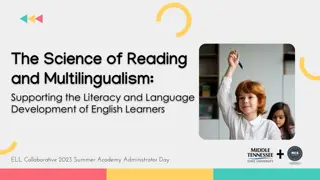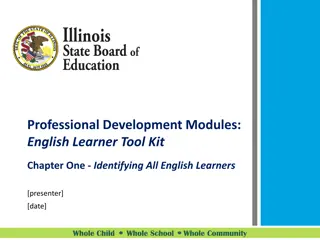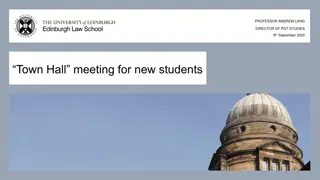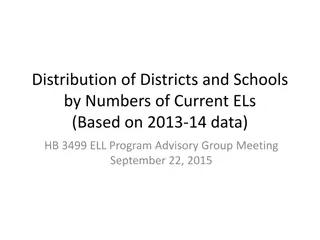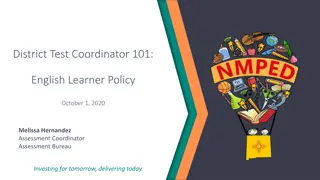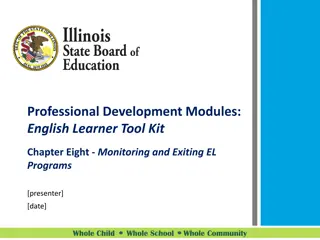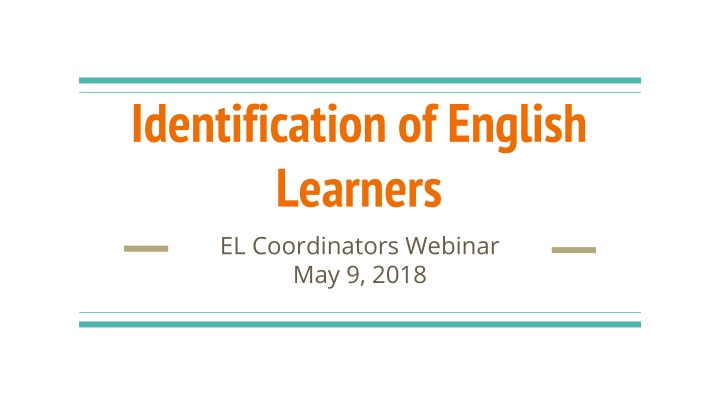
Identifying English Learners: Procedures and Criteria in Education
Learn about the legal requirements and procedures for identifying English learners in education, including assessment procedures, removal of the EL designation, and criteria for English learner status. Understand the definition of an English learner and the steps involved in assessing and supporting these students effectively.
Download Presentation

Please find below an Image/Link to download the presentation.
The content on the website is provided AS IS for your information and personal use only. It may not be sold, licensed, or shared on other websites without obtaining consent from the author. If you encounter any issues during the download, it is possible that the publisher has removed the file from their server.
You are allowed to download the files provided on this website for personal or commercial use, subject to the condition that they are used lawfully. All files are the property of their respective owners.
The content on the website is provided AS IS for your information and personal use only. It may not be sold, licensed, or shared on other websites without obtaining consent from the author.
E N D
Presentation Transcript
Identification of English Learners EL Coordinators Webinar May 9, 2018
Why? Title III, Part A In establishing statewide entrance procedures required under section 3113(b)(2) of the Act, the SEA will ensure that All students who may be English learners are assessed for such status using a valid and reliable instrument within 30 days of enrollment in a school in the State; It has established procedures for identification of English learners after the initial identification period for students who were enrolled at that time but were not previously identified; and It has established procedures for removing the English learner designation from any student who was erroneously identified as an English learner, which must be consistent with Federal civil rights obligations.
English Learner- The term when used with respect to an individual, means an individual - (A) who is aged 3 through 21; (B) who is enrolled or preparing to enroll in an elementary school or secondary school; (C)(i) who was not born in the United States or whose native language is a language other than English; and (ii)(I) who is a Native American or Alaska Native, or a native resident of the outlying areas; and (II) who comes from an environment where a language other than English has had a significant impact on the individual's level of English language proficiency; or (iii) who is migratory, whose native language is a language other than English, and who comes from an environment where a language other than English is dominant; D) whose difficulties in speaking, reading, writing, or understanding the English language may be sufficient to deny the individual (i) the ability to meet the State's proficient level of achievement on State assessments described in section 1111(b)(3); (ii) the ability to successfully achieve in classrooms where the language of instruction is English; or (iii) the opportunity to participate fully in society English Learner 3
ID Slide Identification Administer the Language Use Survey No other language influence - not assessed Language other than English or tribal language evidence English Proficient does not qualify Administer Initial Screener Qualifies for EL Program Parent/Guardian may refuse service; student tested annually Results shared with parents 4
Identification Process 2017-18 and Beyond... Language Use Survey (LUS) - Oregon designed a survey for all districts to implement, optional in 2017-18 and required in 2018-19. Standard scores for initially fluent across all districts, implemented for 2017-18, required for all districts. Option for districts to use either their current language screener or ELPA21 screener for 2018-19, required ELPA21 (or Oregon State EL screener) beginning in 2019-20.
Language Use Survey Questions
Determining Who to Test Based on LUS Once the Language Use Survey is complete, you need to determine if the student is to be administered an identification screener.
Describe languages Note: Responses E and F were vetted with ODE AI/AN staff for confirmation. Questions 3-4 demonstrate a influence of a language other than English, administer screener to ensure student s English language abilities.
What language(s) does your child CURRENTLY speak/express most frequently outside of school? IF OTHER THAN ENGLIGH YES, POTENTIAL EL ADMINISTER SCREENER Use this language for the language of origin field if question 1 did not trigger a language screener. This question is for additional information (if student participates in regular cultural activities with to a significant extent)- POTENTIAL EL ADMINISTER SCREENER 4. Q: 4-6 5. 6. This question is for additional information that may help determine if the screener needs accessibility supports due to a potential disability. For questions 5 and 6 compare these answers with responses to previous questions to ensure there is a significant impact of a language other than English. Note: Native speakers of English who are enrolled in a bilingual program to learn an additional language are not potential ELs.
P Q !
In 2018-19, what do we have to do? Use the final Language Use Survey and the identification screener scores for initially fluent English speaker. Districts have the option of continuing to use their identification screener or ELPA21 identification screener in 2018-19. ODE staff will monitor compliance of implementation during the 2018-19 Fall EL Data Collection, and provide technical assistance to districts identifying students as ELs whose score is at or above the fluent English speaker score.
Fluent Scores For 18-19 Districts have the option of continuing to use their current identification screener or using the ELPA21 screener for 2018-19. Below are the initial fluent scores for the current screeners; fluent scores for ELPA21 screener will be established later this year. ELPA21 Initially Fluent Scores will be all 4 s and 5 s just like the Proficient on the ELPA21 Summative assessment
How to make sure we dont miss out on students needing additional support What to do when? Language Use Survey shows only English with no extra information on cultural activities with other language influence. Student is not screened as an English learner, regardless if student is AI/AN.
Then What? If classroom teacher has concerns regarding student s use of academic English: Then the teacher completes a Language Observation Tool for both oral and written communication (attaches work samples for written). Based on results of the Language Observation Tool, if a student has a score of five or more (No) responses, then the student is screened for academic English proficiency with the identification screener. This process must be completed within 2 weeks of receipt of documentation, and the entire teacher review must be completed within the first 45 days of the student s enrollment.
Draft process to be tested during the 2018-19 school year. ODE is looking for districts who are willing to pilot this process in the fall and provide feedback. To Sign up please fill in this Google Sheet (columns A-E) https://docs.google.com/spreadsheets/d/ 12ROpDG4LsNYurnAEDtR409vKG0HXCeg Hj7gq5J8MtsA/edit?usp=sharing
Suggestions for a way to un-code ELs? What steps would we take if a student is a false-positive EL? Add comments to this Google Sheet (columns A-D and F-H) https://docs.google.com/spreadsheets/d/12ROpDG4LsNYurnAEDtR409vKG0H XCegHj7gq5J8MtsA/edit?usp=sharing
What to look for in the coming months New Executive Numbered Memo on Identification of ELs Adding in ELPA21 Screener scores Providing clarity on identification of AI/AN ELs Training dates for ELPA21 Screener
Who to Call Kim Miller EL Education Specialist EL Lead Kim.a.miller@state.or.us 503-947-5712 Taffy Carlisle EL Education Specialist taffy.carlisle@state.or.us


